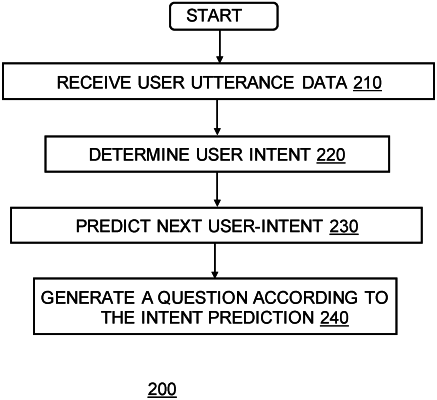| CPC G06F 40/35 (2020.01) [G06F 40/30 (2020.01); G06F 40/40 (2020.01); H04L 51/02 (2013.01); G06F 40/216 (2020.01); G06F 40/279 (2020.01); G06N 3/044 (2023.01); G06N 3/08 (2013.01)] | 14 Claims |

|
1. A computer system for question generation, the computer system comprising:
one or more computer processors;
one or more computer readable storage devices; and
stored program instructions on the one or more computer readable storage devices for execution by the one or more computer processors, the stored program instructions comprising:
program instructions to receive user utterance data;
program instructions to determine an intent confidence vector for the user utterance data;
program instructions to train the next user-intent prediction model comprising:
program instructions to receive historic chatbot conversation data, wherein the chatbot conversation data comprises labeled user-intents and intent confidence vectors for each user utterance of each conversation;
program instructions to separate the chatbot conversation data into training data and validation data;
program instructions to generate a matrix including all the intent confidence vectors for all historic conversation training data;
program instructions to train a machine learning model to classify user-intents using the matrix of training data;
program instructions to drop out at least one intent confidence vector during training;
program instructions to validate the machine learning model using the validation data; and
program instructions to provide a trained next intent predictor mode for use in generating questions:
program instructions to predict, by the trained next user-intent prediction model, a next user-intent confidence vector using the intent confidence vector;
program instructions to generate a next question set using the next user-intent confidence vector;
program instructions to adjust a confidence value of the next user-intent confidence vector according to value ranking for a predefined type of a next user intent provided by a productive value ranking algorithm;
program instructions to generate an ordered version of the next question set ordered according to next user intent confidence vector values adjusted according to the productive value ranking algorithm; and
program instructions to output a subset of the ordered version having a highest value to the user.
|